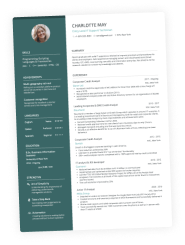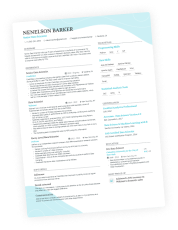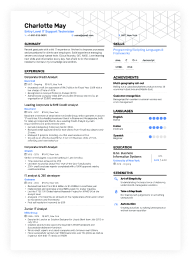Building a career on your own terms takes grit. Maybe you’ve grown a client base from scratch, kept a side hustle alive for years, or turned freelancing into full-time work. When it’s time to apply for new roles, the challenge isn’t proving this experience matters—it’s presenting it in a way that feels credible to recruiters.
Self-employment can mean consulting, contract work, or running your own startup business. On a resume, it reflects initiative, adaptability, and the ability to manage responsibilities without a traditional boss. The key is to write a resume that spotlights what you accomplished—your skills, the projects you delivered, and the impact you created.
Key takeaways
- Treat self-employment as credible work history, not a gap on your resume.
- Select a title that reflects your role—Freelancer, Consultant, Business Owner, or Self-Employed.
- Specify the employer field clearly, whether it’s your business name, Self-Employed, or Independent Contractor.
- Highlight achievements with evidence of impact, not just a list of tasks.
- Match your wording—use freelance for creative projects, self-employed or consultant for broader or specialized roles.
- Prevent red flags with clear dates, concrete results, and polished language.
Upload and check your resume to see how well your self-employed experience is presented and receive instant feedback.
Is your resume good enough?
Drop your resume here or choose a file. PDF & DOCX only. Max 2MB file size.
How to put “self-employed” on a resume
Listing self-employment isn’t complicated once you break it into clear steps. Think of it like displaying any other job in your experience section—you’re just filling in the details in a way that communicates credibility and impact.
Step 1. Choose a professional title
It’s completely fine to list yourself as “Self-Employed” on a resume. The catch is that “Self-Employed” alone rarely matches the job titles recruiters or applicant tracking systems (ATS) look for.
A stronger approach is to use a title that reflects the kind of work you’ve been doing. Common choices include “Freelancer,” “Consultant,” or “Business Owner.” Choose the one that best represents your experience and aligns with the role you’re targeting.
Step 2. Define the employer field
Use “Self-Employed” if you worked independently, or list your registered business name (LLC, DBA) if you have one. For contract-based work, “Independent Contractor” is also acceptable.
Step 3. Add dates and location
Provide a clear timeline with start and end dates, along with the city and state. This keeps your career history straightforward and transparent.
Step 4. Write achievement-driven bullet points
Move beyond describing tasks. Focus on what you accomplished, the skills you applied, and the measurable results you produced. Numbers, growth percentages, and client outcomes all strengthen your case.
Step 5. Keep formatting consistent
Align your self-employment entry with the rest of your work history. Using the same layout and style reinforces that this was professional experience, not a side note.
A strong example on a resume might look like this:
- •Designed and launched 15+ small business websites, leading to a 25% average increase in online sales.
- •Managed projects end-to-end, from client onboarding to final delivery, while maintaining a 95% repeat client rate.
Freelance, self-employed, or consultant: Which wording works best?
Choosing the right label for your independent work can shape how recruiters interpret your experience. Each option carries a slightly different nuance, so select the one that best reflects the type of work you did.
- Freelance: Works well for creative or project-based roles such as design, writing, or web development. It emphasizes flexibility and variety.
- Self-employed: A strong choice if you have managed your own work for several years or balanced a broad mix of projects. It conveys stability and initiative.
- Consultant or independent contractor: Best suited for specialized or advisory work. It signals expertise and professionalism.
There’s no single “correct” label. The right term is the one that makes your background sound most relevant to the role you’re pursuing.
PRO TIP
If you’re applying to a large company or through an ATS, consider naming the section strategically. Titles like “Consultancy Experience,” “Relevant Experience,” or “Design Projects” can make your independent work easier to understand and improve keyword matching.
If you only had one self-employed period, listing it as “Self-Employed” works perfectly well. But if you’ve managed multiple projects or roles, it’s often stronger to create a dedicated section with a descriptive name that highlights your value to recruiters and hiring systems alike.
Resume formats that fit self-employment
Not every resume layout works equally well when you’re presenting self-employment. The best choice depends on how long you worked independently and how relevant that experience is to your target role.
- Chronological: A good fit if you had steady client work or long-term contracts. Listing self-employment like a traditional job highlights continuity and career growth.
- Functional: Useful when your projects were short, diverse, or part-time. A skills-based format lets you group achievements under themes such as project management, design, or consulting.
- Combination: Also known as a hybrid resume, it’s often the strongest option for solo practitioners. It combines a traditional timeline with a prominent skills section, giving space to emphasize both your freelance work history and your core strengths.
Whichever resume format you choose, make sure the entry looks polished and professional.
For most freelancers or consultants, the hybrid (combination) format tends to strike the best balance—it gives structure to your career timeline while letting your project-based achievements shine.
Author’s take
Recruiter concerns and red flags (and how to avoid them)
Some job seekers hesitate to list self-employment because they worry recruiters will dismiss it. In reality, most doubts disappear when your resume is specific and professional.
- Vagueness: A line like “Did freelance work” leaves questions. Specify the type of projects, the skills you applied, and the value you brought to clients.
- Unclear dates:Gaps in your timeline can raise suspicion. Use clear start and end dates, even if the work was part-time, or consider a functional resume format that emphasizes your top skills and achievements rather than specific job dates.
- Odd job descriptions: Avoid wording such as “odd jobs” or “side work.” Use professional terms like Independent Contractor or Consultant.
- No proof of results: Recruiters want to see proof that your work made a difference. Use numbers, client testimonials, or retention rates to demonstrate value beyond a task list.
Handled with care, self-employment conveys independence, adaptability, and initiative—qualities that strengthen your application rather than weaken it.
Conclusion
Self-employment can become a powerful part of your career story when you present it with clarity. It reflects ambition, resilience, and the ability to succeed without a traditional employer. The key is to frame that experience in language recruiters recognize and connect it directly to the role you’re pursuing. Do that, and your independent work won’t just fit on a resume—it will stand out as a genuine advantage.
Make one that's truly you.



